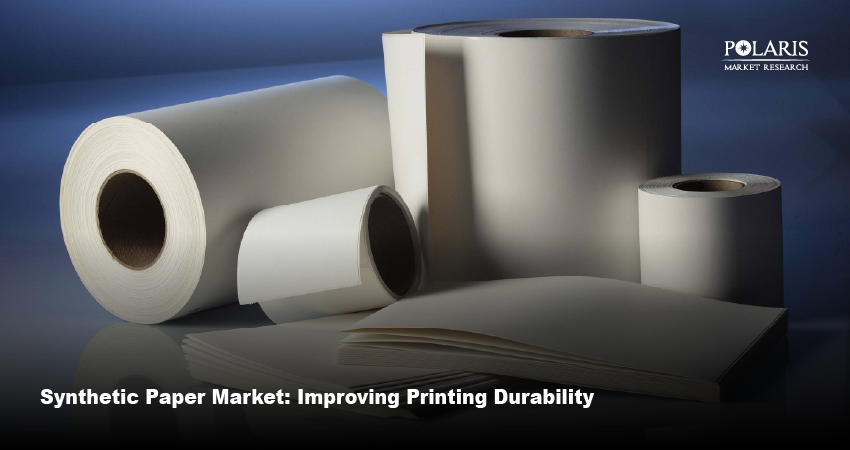Synthetic Paper Market: Improving Printing Durability

Printing has changed over the years. Today’s printing environment is characterized by its high-demand and fast-paced nature. As such, traditional paper may not always be the best choice. And this is especially the case with applications that need durable and long-lasting environments. The demands of modern printing have led to the introduction of advanced printing materials. And one of them is synthetic paper.
Curious to know more about synthetic paper and its uses? Our detailed blog on the synthetic paper market has everything covered. Keep reading!
What Is Synthetic Paper?
Synthetic paper is a type of plastic-based printing material. It is created to be compatible with laser printers and copiers. Synthetic paper is different from traditional paper, which is made from wood pulp. Instead, it makes use of polyester, polyethylene, or polypropylene. These polymers make it waterproof and resistant to tears. They also allow it to resist chemicals.
Synthetic paper available in the synthetic paper market is made of plastic. But its appearance and texture are similar to those of traditional paper. Its availability in different sizes and finishes makes it useful for various applications. Another notable thing about synthetic paper is that it can tolerate the high heat of laser printing. Additionally, its resistance to wrapping and degradation allows for strong adhesion and clear images.
How Is Synthetic Paper Produced?
There are several stages involved in the production process of synthetic paper. These steps transform resins into a material that feels and functions like real paper. This process starts with the heating of polymers. Heating is done until the polymer is transformed into a thick liquid. The liquid is then made to pass through an extruder. Here, it spreads out into a long and flat sheet.
Quick cooling is done after the formation of the sheet. After this, the biaxial orientation technique is used to stretch it in two directions. Stretching is needed to make the material stronger and more flexible. Stretching also makes it better for printing. Then the sheet is moved through rollers that help control its thickness and give it a smooth texture.
There are several printing ink options available for synthetic paper, as available in the printing inks market. At this stage, manufacturers may opt to add coatings or surface treatments to improve the ink's absorbability by the sheet. Coatings can also be used to give the material different finishes. Once done, the material is rolled up and cut into different sizes. Then it’s prepared for use in different applications. Overall, the process creates a durable material that functions like paper but is more durable and long-lasting.
What Are Benefits of Synthetic Paper?
Tear Resistance: Synthetic paper has a molecular structure that allows it to be much more robust than traditional paper, thus making it highly resistant to tears. The stability of synthetic paper dramatically improves its durability. Print materials that are handled frequently or used in hostile environments will benefit from synthetic paper's strength.
Water Resistance: Traditional paper absorbs water and becomes limp upon exposure to a liquid. Synthetic paper does not allow water or other related liquids to penetrate its surface, and it stays dry. Thus, it is more reliable in environments that are humid or wet.
Oil Resistance: Synthetic paper will not absorb oil or greasy materials, unlike typical paper. Thus, it is safe for print materials designed to be used in commercial kitchens or manufacturing facilities. Synthetic paper is also used in any environments that will come into contact with oil, such as in the automotive and manufacturing industries.
Easy to Clean: Synthetic paper has a smooth surface, allowing stains to be wiped away and cleaned off easily, making it overwhelmingly popular for restaurant menus.
Environmental Sustainability: Synthetic paper is recyclable. It can also be manufactured without using trees, reducing the environmental impact of traditional paper manufacturing processes.
Where Is Synthetic Paper Used?
Printing and Graphics
The printing and graphics sector makes use of synthetic paper for several applications. Its high print quality makes it suitable for applications such as posters, business cards, and brochures. The vibrant colors and sharp images enabled by synthetic paper improve the visual appeal of printed materials.
Labelling and Packaging
The packaging industry makes use of synthetic paper for tags and labels. Synthetic paper also finds applications in the flexible packaging market. The moisture resistance capabilities of the paper make sure that the label and packaging stay intact. Another notable thing about synthetic paper is that it’s also compatible with various printing technologies.
Maps and Charts
Maps and charts are handled frequently. They are also exposed to various elements. As such, they need robust materials. Synthetic paper is suitable for map printing as it can resist tears and has excellent print quality. It makes sure that charts and maps stay legible in challenging outdoor conditions.
Book Publishing
The synthetic paper market has also made its way into book publishing. This is due to the durable and high print quality of the paper. It can resist tears and staining. So, the lifespan is longer than that of traditional paper books.
What Are Recent Market Developments?
September 2025: Cosmo Films added CSP Dualcoat to its Cosmo Synthetic Paper range. The company stated that the new product is focused on offering high print quality and making prints last longer. It is also aimed at being suitable for a wide range of printing methods.
November 2024: Huge Paper partnered with Yupo for the introduction of SuperYupo synthetic paper in Canada. According to Huge Paper, the new product line allows for double-sided printing with the use of standard paper inks.
Conclusion
The use of synthetic paper has increased over the past few years. This is due to the various benefits synthetic paper has to offer. The key players in the synthetic paper market are increasingly focused on the development of more advanced solutions to meet the diverse requirements of sectors.

